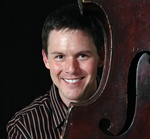
|

|

|

|
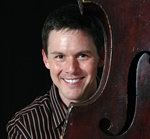
|
|
|
|
|
|
|
|
|
(8 Brass) In 4/4 despite the title, this is a hard-swinging, bluesy, audience-pleasing chart, similar in vibe to some of the music of the Clayton-Hamilton Jazz Orchestra. It features tenor all the way through (the ³T¹ is Stanley Turrentine), playing over an infectious blues groove. The ensemble interjects brief melodic statements and adds backgrounds that build to a great climax. An accessible chart for high school players, but very satisfying for college and pro bands as well. Written for the Colorado Jazz Orchestra.
By purchasing this product, you agree not to reproduce, duplicate, copy, sell, resell, or exploit for any purpose, any portion of the music, use of the music, any data or image or access to the music. This download is intended for use by the purchaser only. Usually one (1) copy for one (1) ensemble.
PDF downloads are intended to be printed 1x by the consumer. It is against copyright law to distribute.
View all charts by Erik Applegate
|
Tale Of The Open Road (9 Brass) A sophisticated contemporary piece with creative architecture and orchestral colors, reminiscent of the Pat Metheny Group. A haunting chant-like melody played by solo piano and then joined by tenor continues to develop over a straight 3/4 (or 6/8) groove. This leads to a tenor solo beginning over a bass vamp that moves into the changes of the tune. A piano solo continues from the tenor solo and leads to a development section with a memorable melody. Commissioned by Gene Aitken for the 2008 UNC/Greeley Jazz Festival All-Stars, and recorded by UNC Jazz Lab Band I on their upcoming CD.
By purchasing this product, you agree not to reproduce, duplicate, copy, sell, resell, or exploit for any purpose, any portion of the music, use of the music, any data or image or access to the music. This download is intended for use by the purchaser only. Usually one (1) copy for one (1) ensemble.
PDF downloads are intended to be printed 1x by the consumer. It is against copyright law to distribute.
View all charts by Erik Applegate
|
...And Especially - (Level IV) Written for the great drummer Ronnie Bedford, this is a high-energy but medium-tempo hard bop swing chart, playable by advanced high school groups and well suited for colleges and pro bands. After the head and a memorable sax soli, there is solo space for drums and bass (the bass solo section, with medium-difficulty changes, can be opened up for any additional or alternate soloist). After the solos, there is a grooving shout chorus that builds to an exciting finish.
(8 Brass)
By purchasing this product, you agree not to reproduce, duplicate, copy, sell, resell, or exploit for any purpose, any portion of the music, use of the music, any data or image or access to the music. This download is intended for use by the purchaser only. Usually one (1) copy for one (1) ensemble.
PDF downloads are intended to be printed 1x by the consumer. It is against copyright law to distribute.
View all charts by Erik Applegate
|

|

|

|

|

|

|
|
|
|
|
|
|
|
|
Beyond Thursday - (Level IV) is an arrangement by Will Campbell on the original composition by Scott Wendholt, trumpet soloist with the Village Vanguard Orchestra. This progressive arrangement is in 6/4 meter and features solo trumpet, which is joined by tenor saxophone and trombone on the melody. There is a soli for the saxophone section and powerful tutti sections to contrast the improvised section for trumpet. The solo section may be extended, with backgrounds the last time through the form. (8 Brass)
By purchasing this product, you agree not to reproduce, duplicate, copy, sell, resell, or exploit for any purpose, any portion of the music, use of the music, any data or image or access to the music. This download is intended for use by the purchaser only. Usually one (1) copy for one (1) ensemble.
PDF downloads are intended to be printed 1x by the consumer. It is against copyright law to distribute.
|
|
View all charts by Will Campbell
|
Body and Soul - (Level IV) This exciting chart features the lead alto and uses Coltrane’s substitute changes on this standard. There are also unaccompanied solis for the brass and saxophone sections. A mixed meter coda is used to simulate the original recording. A great chart to feature both the soloist and the ensemble. (8 Brass)
By purchasing this product, you agree not to reproduce, duplicate, copy, sell, resell, or exploit for any purpose, any portion of the music, use of the music, any data or image or access to the music. This download is intended for use by the purchaser only. Usually one (1) copy for one (1) ensemble.
PDF downloads are intended to be printed 1x by the consumer. It is against copyright law to distribute.
|
|
View all charts by Will Campbell
|
Olive Street - (Level IV) features lead alto with well-complemented ensemble sections. The chord progression takes harmonic “left turns” to create an interesting tonal landscape. A saxophone soli is also included within an exciting shout chorus. This is a perfect chart for an ensemble looking for a modern chart within a comfortable tempo. (8 Brass)
By purchasing this product, you agree not to reproduce, duplicate, copy, sell, resell, or exploit for any purpose, any portion of the music, use of the music, any data or image or access to the music. This download is intended for use by the purchaser only. Usually one (1) copy for one (1) ensemble.
PDF downloads are intended to be printed 1x by the consumer. It is against copyright law to distribute.
|
|
View all charts by Will Campbell
|

|

|

|
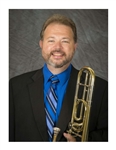
|

|

|
|
|
|
|
|
|
|
|
We Three Kings (Level III) This
arrangement is a modern jazz interpretation of the holiday standard and would
be an excellent addition to a concert of seasonal music. The chart begins with an open bass solo in G
minor in the style of Jimmy Garrison. The melody is shared by a small group of
horns in a modal style with advanced chord substitutions and is followed by
solo space for trumpet (with backgrounds). After the shout chorus, the chart
concludes with an open vamp for the trumpet soloist, followed by a brief
chorale coda
, (8 Brass)
By purchasing this product, you agree not to reproduce, duplicate, copy, sell, resell, or exploit for any purpose, any portion of the music, use of the music, any data or image or access to the music. This download is intended for use by the purchaser only. Usually one (1) copy for one (1) ensemble.
PDF downloads are intended to be printed 1x by the consumer. It is against copyright law to distribute.
View all charts by Will Campbell
|
Fantasia On Kang Ding Love Song (Level IV) Written for the Shanghai Conservatory of Music Jazz Orchestra (Zhang, Xiaolou director) and premiered in concert under the direction of Gene Aitken on October 30, 2008. This new concert work for jazz orchestra is based on the theme of a traditional Chinese folk song. FANTASIA… explores several treatments of the theme, from chamber music to contemporary big band jazz. No woodwind doubles; optional solo alto flute part (cued into Alto Saxophone I). Alto saxophone section lead (no woodwind doubles).
By purchasing this product, you agree not to reproduce, duplicate, copy, sell, resell, or exploit for any purpose, any portion of the music, use of the music, any data or image or access to the music. This download is intended for use by the purchaser only. Usually one (1) copy for one (1) ensemble.
PDF downloads are intended to be printed 1x by the consumer. It is against copyright law to distribute.
|
|
View all charts by Eric Richards
|
Erbil Street Samba (Level V) Commissioned for the 2008 UNC Greeley Jazz Festival Big Band by Gene Aitken. This exciting “street samba” is written in tribute to Gene’s work with jazz education outreach to the young musicians of Erbil, Iraq. The piece features Trumpet IV, Trombone II, and Guitar. No woodwind doubles (optional piccolo on Alto II). Soprano saxophone section lead.
By purchasing this product, you agree not to reproduce, duplicate, copy, sell, resell, or exploit for any purpose, any portion of the music, use of the music, any data or image or access to the music. This download is intended for use by the purchaser only. Usually one (1) copy for one (1) ensemble.
PDF downloads are intended to be printed 1x by the consumer. It is against copyright law to distribute.
|
|
View all charts by Eric Richards
|

|

|

|

|

|

|
|
|
|
|
|
|
|
|
Samba For Sensei (Level V) Commissioned for the 2006 UNC Greeley Jazz Festival Big Band by Gene Aitken.
This extended samba for big band is set in a variant of the infectious “Partido Alto” feel and makes a great opener or closer. Soprano saxophone section lead (no woodwind doubles). Features Trumpet IV and Trombone II.
By purchasing this product, you agree not to reproduce, duplicate, copy, sell, resell, or exploit for any purpose, any portion of the music, use of the music, any data or image or access to the music. This download is intended for use by the purchaser only. Usually one (1) copy for one (1) ensemble.
PDF downloads are intended to be printed 1x by the consumer. It is against copyright law to distribute.
|
|
View all charts by Eric Richards
|
The View From The Villa (Level V) Commissioned for the 2007 UNC Greeley Jazz Festival Big Band by Gene Aitken.
THE VIEW FROM THE VILLA is based on a contemporary reworking of “Rhythm” changes set in a “calypso funk” groove (think “Son of St. Thomas”). The chart opens with an exciting unison ensemble soli and then features Trumpet IV and Trombone II. Soprano saxophone section lead (no woodwind doubles).
By purchasing this product, you agree not to reproduce, duplicate, copy, sell, resell, or exploit for any purpose, any portion of the music, use of the music, any data or image or access to the music. This download is intended for use by the purchaser only. Usually one (1) copy for one (1) ensemble.
PDF downloads are intended to be printed 1x by the consumer. It is against copyright law to distribute.
|
|
View all charts by Eric Richards
|
(Level IV) What Child Is This – A perennial Christmas favorite set to the tune of a traditional English
folk song
Greensleeves is now a spirited jazz waltz. The news
of a new child travels through a winter's night with cold wind swirling in the
air. Tension builds as the voices weave the question "Why lies He in such
mean estate?" but eventually culminates in a joyous exclamation to welcome
the savior. Written for Vox One.
.
SATBB a cappella.
PDF downloads are intended to be printed 1x by the consumer. It is against copyright law to distribute.
View all charts by Yumiko Matsuoka
|

|

|

|

|

|

|
|
|
|
|
|
|
|
|
(Level IV) The Wexford Carol – One of the oldest Christmas carols from County
Wexford in Ireland, it features a soprano solo throughout. Opens with a bed of
chords to light up the darkness and welcome the pure voice that announces the
savior's arrival. In the second and third verses there is some reharmonization
to savor as it builds to the shepherds' encounter with the "Lord of
Light." A quiet afterthought closes the tune. Written for Vox
One.
SATB a cappella.
PDF downloads are intended to be printed 1x by the consumer. It is against copyright law to distribute.
View all charts by Yumiko Matsuoka
|
(Level IV) Annie Laurie – Paying homage to the beautiful Annie Laurie
and Scotland, this arrangement evokes a bucolic landscape while featuring the
baritone, soprano and tenor solos. Somewhat similar to Danny Boy, the
arrangement starts off with the background lines weaving a little brook. In the
second verse, different parts have some counter-lines that are their
"solo" moments to be brought out. The song builds to its climax at
measures 60 - 62, followed by a reflective moment of silence and the ending
reminiscent of the intro. Written for Vox One.
SATB a cappella.
PDF downloads are intended to be printed 1x by the consumer. It is against copyright law to distribute.
View all charts by Yumiko Matsuoka
|
(Level IV) Air on the G String The timeless J. S. Bach classic becomes a light and airy waltz! True to the original harmony, the background that supports the soprano melody is elegantly arpeggiated by the three lower parts. Originally written for Vox One as a demo for a Japanese TV jingle, the piece can be enjoyed by small or large ensemble. SATB a Capella.
By purchasing this product, you agree not to reproduce, duplicate, copy, sell, resell, or exploit for any purpose, any portion of the music,
use of the music, any data or image or access to the music. This download is intended for use by the purchaser only.
Usually one (1) copy for one (1) ensemble.
PDF downloads are intended to be printed 1x by the consumer. It is against copyright law to distribute.
|
|
View all charts by Yumiko Matsuoka
|

|

|

|

|

|

|
|
|
|
|
|
|
|
|
|
Boogalues - (Level IV) This is medium Boogaloo blues in the key of D, written as a guitar feature in the style of Wes Montgomery (melody in octaves). It is appropriate for strong high school bands, as well as college and professional groups. The two solo sections feature guitar and trumpet, but can easily be opened up for more improvisers. This chart provides a nice change of pace from the typical funky big band chart. (9 Brass)
By purchasing this product, you agree not to reproduce, duplicate, copy, sell, resell, or exploit for any purpose, any portion of the music, use of the music, any data or image or access to the music. This download is intended for use by the purchaser only. Usually one (1) copy for one (1) ensemble.
PDF downloads are intended to be printed 1x by the consumer. It is against copyright law to distribute.
|
|
View all charts by Steve Kovalcheck
|
(Level III) Hey Momma’ Blues - PDF Download is a medium swing blues, written to capture to essence of the 1950s Count Basie Orchestra, is appropriate for high school groups as well as college and professional bands. It features solos for piano, lead alto, and lead trombone. This chart could easily be opened up for extended solos. Hey Momma’ Blues includes a sax soli and contrast-ing ensemble shout sections which build to an exciting finish. (8 Brass)
Please email or call Rex at 970-351-2492 [email protected] for Hey Momma Blues Score.
By purchasing this product, you agree not to reproduce, duplicate, copy, sell, resell, or exploit for any purpose, any portion of the music, use of the music, any data or image or access to the music. This download is intended for use by the purchaser only. Usually one (1) copy for one (1) ensemble.
PDF downloads are intended to be printed 1x by the consumer. It is against copyright law to distribute.
View all charts by Steve Kovalcheck
|

|

|

|

|

|

|
|
|
|
|
|
|
|
|
Boogalues - (Level IV) This is medium Boogaloo blues in the key of D, written as a guitar feature in the style of Wes Montgomery (melody in octaves). It is appropriate for strong high school bands, as well as college and professional groups. The two solo sections feature guitar and trumpet, but can easily be opened up for more improvisers. This chart provides a nice change of pace from the typical funky big band chart. (9 Brass)
View all charts by Steve Kovalcheck
|
We Three Kings - (Level III) This
arrangement is a modern jazz interpretation of the holiday standard and would
be an excellent addition to a concert of seasonal music. The chart begins with an open bass solo in G
minor in the style of Jimmy Garrison. The melody is shared by a small group of
horns in a modal style with advanced chord substitutions and is followed by
solo space for trumpet (with backgrounds). After the shout chorus, the chart
concludes with an open vamp for the trumpet soloist, followed by a brief
chorale coda.
(8 Brass)
View all charts by Will Campbell
|
(Level IV) What Child Is This – A perennial Christmas favorite set to the tune of a traditional English
folk song
Greensleeves is now a spirited jazz waltz. The news
of a new child travels through a winter's night with cold wind swirling in the
air. Tension builds as the voices weave the question "Why lies He in such
mean estate?" but eventually culminates in a joyous exclamation to welcome
the savior. Written for Vox One.
.
SATBB a cappella.
View all charts by Yumiko Matsuoka
|

|

|

|

|

|

|
|
|
|
|
|
|
|
|
(Level IV) The Wexford Carol – One of the oldest Christmas carols from County
Wexford in Ireland, it features a soprano solo throughout. Opens with a bed of
chords to light up the darkness and welcome the pure voice that announces the
savior's arrival. In the second and third verses there is some reharmonization
to savor as it builds to the shepherds' encounter with the "Lord of
Light." A quiet afterthought closes the tune. Written for Vox
One.
SATB a cappella.
View all charts by Yumiko Matsuoka
|
(Level IV) Annie Laurie – Paying homage to the beautiful Annie Laurie
and Scotland, this arrangement evokes a bucolic landscape while featuring the
baritone, soprano and tenor solos. Somewhat similar to Danny Boy, the
arrangement starts off with the background lines weaving a little brook. In the
second verse, different parts have some counter-lines that are their
"solo" moments to be brought out. The song builds to its climax at
measures 60 - 62, followed by a reflective moment of silence and the ending
reminiscent of the intro. Written for Vox One.
SATTB a cappella.
View all charts by Yumiko Matsuoka
|
(Level IV) Medium hip-hop. A vocal (alto) feature with solo opportunities for piano, guitar, and drums. This chart is hard-hitting and smooth at different times. The band and soloists are led through a series of musical textures that change shape, but are always grooving.
9 Brass w/ Vocals
View all charts by Adam Bartczak
|

|

|

|

|

|

|
|
|
|
|
|
|
|
|
(Level IV) Medium swing. Written as a tribute to (and in the style of) a good friend and excellent pianist, Ronneka Cox. This chart features lead tenor and piano solos, as well as a short drum solo. Changes alternate between a harmonically rich textured "12-tone blues" and a straight-ahead minor blues. 9 Brass
View all charts by Adam Bartczak
|
|
(8 Brass) This piece was the winner of the 2007 BMI Foundation Charlie Parker Composition Prize. It has been built on three themes that are announced in the introduction and manipulated throughout the composition. The arch form (intro, A, B, C, piano solo, C, B, A, coda) and tonal arrangement (centricity around D) have been inspired by the string quartets of Bela Bartok. This piece moves through Even 8th, Fast Swing and Latin time feels as well.
View all charts by Jose Bevia
|

|

|

|

|

|

|
|
|
|
|
|
|
|
|
(8 Brass) In 4/4 despite the title, this is a hard-swinging, bluesy, audience-pleasing chart, similar in vibe to some of the music of the Clayton-Hamilton Jazz Orchestra. It features tenor all the way through (the ³T¹ is Stanley Turrentine), playing over an infectious blues groove. The ensemble interjects brief melodic statements and adds backgrounds that build to a great climax. An accessible chart for high school players, but very satisfying for college and pro bands as well. Written for the Colorado Jazz Orchestra.
View all charts by Erik Applegate
|
(9 Brass) A sophisticated contemporary piece with creative architecture and orchestral colors, reminiscent of the Pat Metheny Group. A haunting chant-like melody played by solo piano and then joined by tenor continues to develop over a straight 3/4 (or 6/8) groove. This leads to a tenor solo beginning over a bass vamp that moves into the changes of the tune. A piano solo continues from the tenor solo and leads to a development section with a memorable melody. Commissioned by Gene Aitken for the 2008 UNC/Greeley Jazz Festival All-Stars, and recorded by UNC Jazz Lab Band I on their upcoming CD.
View all charts by Erik Applegate
|
(Level IV) Written for the great drummer Ronnie Bedford, this is a high-energy but medium-tempo hard bop swing chart, playable by advanced high school groups and well suited for colleges and pro bands. After the head and a memorable sax soli, there is solo space for drums and bass (the bass solo section, with medium-difficulty changes, can be opened up for any additional or alternate soloist). After the solos, there is a grooving shout chorus that builds to an exciting finish.
|

|

|

|

|

|

|
|
|
|
|
|
|
|
|
Erbil Street Samba (Level V) Commissioned for the 2008 UNC Greeley Jazz Festival Big Band by Gene Aitken. This exciting “street samba” is written in tribute to Gene’s work with jazz education outreach to the young musicians of Erbil, Iraq. The piece features Trumpet IV, Trombone II, and Guitar. No woodwind doubles (optional piccolo on Alto II). Soprano saxophone section lead.
|
|
View all charts by Eric Richards
|
Fantasia On Kang Ding Love Song (Level IV) Written for the Shanghai Conservatory of Music Jazz Orchestra (Zhang, Xiaolou director) and premiered in concert under the direction of Gene Aitken on October 30, 2008. This new concert work for jazz orchestra is based on the theme of a traditional Chinese folk song. FANTASIA… explores several treatments of the theme, from chamber music to contemporary big band jazz. No woodwind doubles; optional solo alto flute part (cued into Alto Saxophone I). Alto saxophone section lead (no woodwind doubles).
|
|
View all charts by Eric Richards
|
Description to Follow.
View all charts by Alf Clausen
|

|
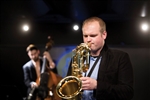
|

|

|

|
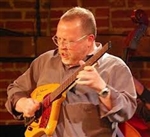
|
|
|
|
|
|
|
|
|
(9 Brass) Lighthouse is a Multi-sectional piece that starts with gentle ensemble writing and grows into a full and driving rock section. This piece is a great feature for a versatile tenor saxophone soloist and an aggressive trumpet soloist. No woodwind doubles, but optional flugelhorn doubles. Optional auxiliary percussion part (cajon or djembe). Recorded on Renovation (Northern Iowa Jazz Band One).
View all charts by Ryan Middagh
|
(9 Brass) The There Be Nothing is a multi-sectional piece that truly covers the range of human emotion. Dedicated to the Beta Nu chapter of Phi Mu Alpha Sinfonia, this piece blurs the line between composition and improvisation and allows each member of the ensemble to be a part of the creative process. The piece calls for and features a violin soloist and also includes a trombone soloist. Alto doubles on flute and soprano sax; bari doubles on clarinet; two trumpets double on flugelhorn. Recorded on Thinking Globally, Acting Locally (Northern Iowa Jazz Band One).
View all charts by Ryan Middagh
|
(Level IV) In These Rooms is a lightly swinging moderate jazz waltz in the style of John Abercrombie or Pat Metheny and very relaxed and thoughtful in the vibe of the piece. The introduction and solo section use densely scored simple melodic statements alternating with solo space for the lead guitarist. The changes utilize shifting modes and suspended chords, with no ii-V-I. Rhythms, except for occasional use of the ‘quartuplet’, are very simple. (five electric guitars, bass, and drums)
View all charts by Kevin Brunkhorst
|

|

|

|

|

|

|
|
|
|
|
|
|
|
|
(Level IV) Jazz Nonet. Just Missed You uses the Latin ‘tombao’ rhythm. In keeping with the Cuban style, additional percussionists could be easily added. The melody is shared by alto and trumpet. The first phrase of the melody is seven bars, and this unevenness gives it a sense of ‘leaning forward’, especially in the tenor solo section. Cadences are built around a iv-V-bII formula. Articulations should always favor the offbeats, and the horns sound better if they ‘lay back’. The piano solo before the DS may be opened up. (trumpet, trombone; baritone, tenor, and alto saxes; guitar, piano, bass, drums)
View all charts by Kevin Brunkhorst
|
(Level IV) Jazz Nonet. More Issues is a 16th-note funk of the driving kind, not the swinging kind. It’s a lot of fun for the rhythm section. Tenor saxophone is the featured soloist. The melody is in tenor and guitar; the guitarist can use a slightly overdriven rock sound if he/she blends with the ensemble. A series of rhythm breaks leads to the full solo. Backgrounds are in long tones and closely scored. The soloist must understand modes of the melodic minor scale. Trumpet range is only high in the closing phrases of the melody. (trumpet, trombone; baritone, tenor, and alto saxes; guitar, piano, bass, drums)
View all charts by Kevin Brunkhorst
|
(Level IV) Jazz Nonet. Only features the trombone. It opens with a rubato theme statement; the band enters gradually around the 31-bar melody. The trombone solo threads its way around band figures; rhythmic and harmonic tension builds, then declines rapidly, leading to an open solo cadenza. There is a brief recapitulation. Harmony and key centers are advanced; the soloist must understand altered dominants and diminished-major 7th sounds. Range is not difficult. The emphasis is on blend and nuance.(flugelhorn, trombone; baritone, tenor, and alto saxes; guitar, piano, bass, drums)
View all charts by Kevin Brunkhorst
|

|
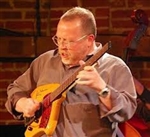
|

|

|

|

|
|
|
|
|
|
|
|
|
(Leve IV) Excerpt from ‘The Way Up’, Part One is a guitar ensemble reading of the first theme (approximately the first six minutes) of Part One of The Pat Metheny Group’s 2005 epic ‘The Way Up’. The lead guitar part takes on much of Pat’s role as melodic player and soloist, though guitars 2 and 3 sometimes play Pat’s overdubbed melodic parts. There is a fairly long solo section with interesting modal changes, and everyone has strong roles in supporting and building around the soloist. Be careful not to let the ensemble build too quickly around the soloist! This chart is good for students of the Metheny/Mays sound, and a favorite with audiences. (five electric guitars, electric bass, and drums)
View all charts by Kevin Brunkhorst
|
Hey Momma’ Blues - (Level III) is a medium swing blues, written to capture to essence of the 1950s Count Basie Orchestra, is appropriate for high school groups as well as college and professional bands. It features solos for piano, lead alto, and lead trombone. This chart could easily be opened up for extended solos. Hey Momma’ Blues includes a sax soli and contrasting ensemble shout sections which build to an exciting finish. (8 Brass)
View all charts by Steve Kovalcheck
|
Groovish - (Level III) is a bluesy medium swing chart, inspired by John Clayton’s writing. It is suitable for advanced high school bands as well as college and professional groups. It features solos for piano, guitar, and second tenor saxophone. These solos could easily be extended. Groovish includes a number of ensemble shout sections util-izing call and response between brass and winds. This chart also features a soli scored for trumpet 2, guitar, alto sax 2, tenor sax 1, and trombone 1. This is an exciting chart which combines the big band tradition with a few unexpected twists. (8 Brass)
View all charts by Steve Kovalcheck
|

|

|

|

|

|

|
|
|
|
|
|
|
|
|
Beyond Thursday - (Level IV) is an arrangement by Will Campbell on the original composition by Scott Wendholt, trumpet soloist with the Village Vanguard Orchestra. This progressive arrangement is in 6/4 meter and features solo trumpet, which is joined by tenor saxophone and trombone on the melody. There is a soli for the saxophone section and powerful tutti sections to contrast the improvised section for trumpet. The solo section may be extended, with backgrounds the last time through the form. (8 Brass)
|
|
View all charts by Will Campbell
|
(Level 5) (Trumpet, Tenor Sax., Trombone, Rhythm) This upbeat piece was commissioned by the University of Nebraska-Lincoln Jazz Combo I for the 2008 UNC/Greeley Jazz Festival. It is an exciting contemporary concert piece generally built over a funky mixed meter (6+7). The piece features trumpet, tenor saxophone, and trombone.
View all charts by Jeff Richmond
|
(Level 5) (Alto Saxophone, Tenor Saxophone) Velvet Rope is a tour de force well suited for top level college jazz bands and professional bands alike. The piece features uncommon meters (mostly 7/4) superimposed over a piece which ebbs and flows with a deep memorable melody. The piece features both alto and tenor saxophone. Standard doubles.
View all charts by Jeff Richmond
|

|